Analysis of WACC for Australian Companies and Decision Making
VerifiedAdded on 2023/06/07
|5
|1428
|421
Report
AI Summary
This report provides a detailed analysis of the Weighted Average Cost of Capital (WACC) and its application in financial decision-making. It begins with a table of contents and descriptions of several Australian companies, including Telstra, Woolworths, Wesfarmers, Commonwealth Bank, and Beach Energy, along with their stock symbols and brief business descriptions. The report explains the WACC computation process, outlining the three key steps: calculating the cost of capital components (debt and equity), determining the proportion of debt and equity in the company's capital structure, and weighing the cost of each capital form. It also explains why firms need to know the WACC and how it aids in decision-making, such as evaluating new projects with similar or different risks and computing Net Present Value (NPV). Furthermore, the report delves into the determination of WACC components, including risk-free return, market return, and beta. The report also discusses why WACC differs among companies, primarily due to variations in debt-to-equity ratios, beta, and other risk factors. Finally, the report includes a list of references used in its preparation.
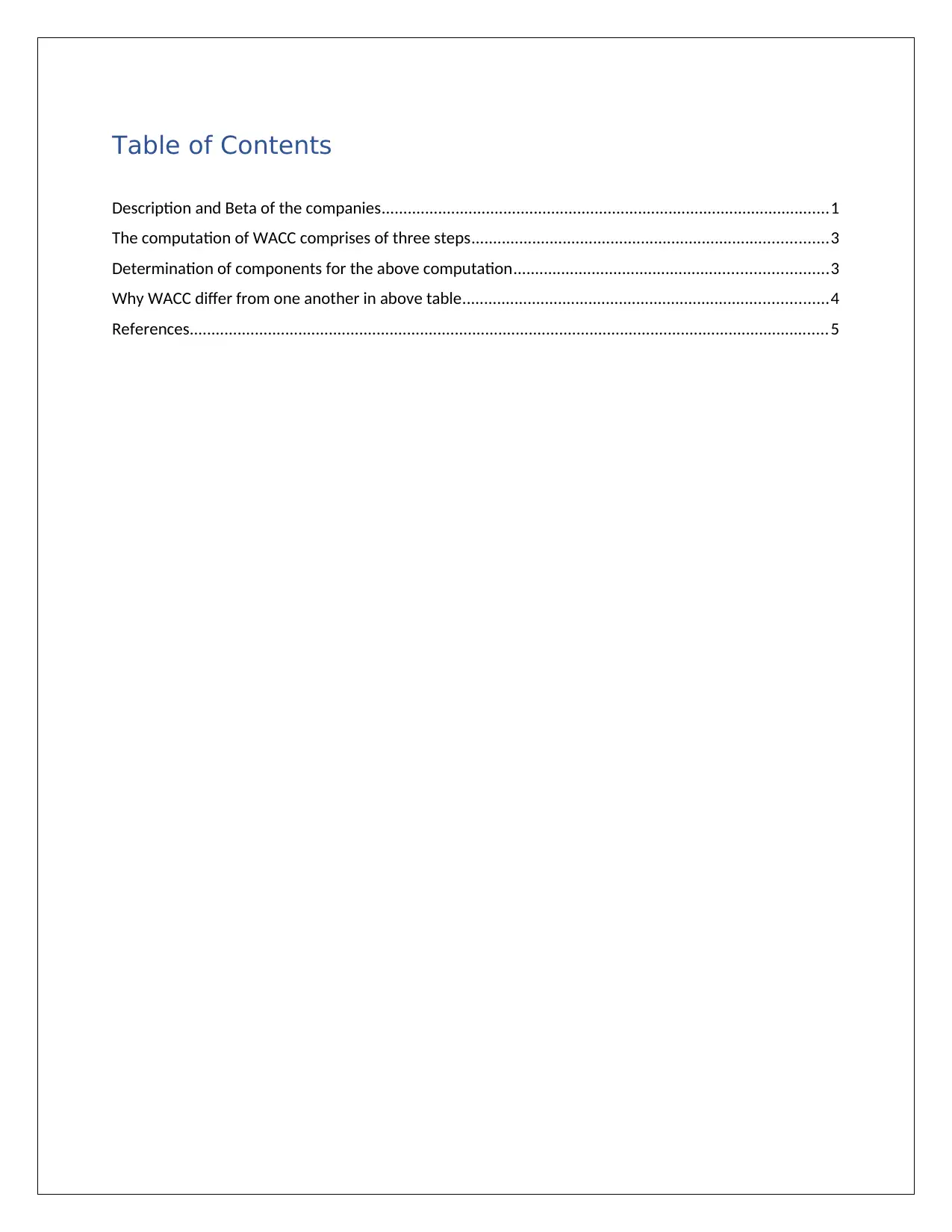
Table of Contents
Description and Beta of the companies.......................................................................................................1
The computation of WACC comprises of three steps..................................................................................3
Determination of components for the above computation........................................................................3
Why WACC differ from one another in above table....................................................................................4
References...................................................................................................................................................5
Description and Beta of the companies.......................................................................................................1
The computation of WACC comprises of three steps..................................................................................3
Determination of components for the above computation........................................................................3
Why WACC differ from one another in above table....................................................................................4
References...................................................................................................................................................5
Paraphrase This Document
Need a fresh take? Get an instant paraphrase of this document with our AI Paraphraser
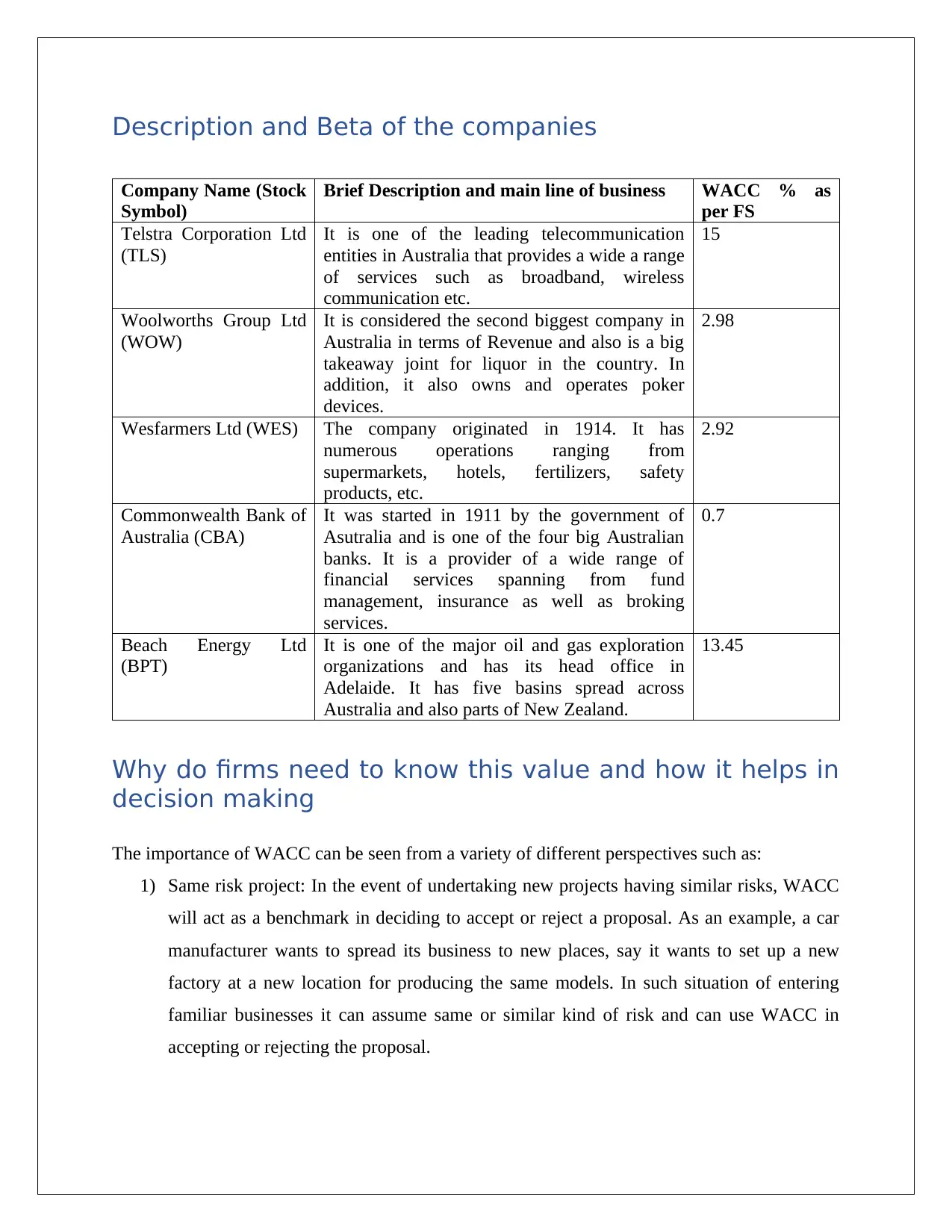
Description and Beta of the companies
Company Name (Stock
Symbol)
Brief Description and main line of business WACC % as
per FS
Telstra Corporation Ltd
(TLS)
It is one of the leading telecommunication
entities in Australia that provides a wide a range
of services such as broadband, wireless
communication etc.
15
Woolworths Group Ltd
(WOW)
It is considered the second biggest company in
Australia in terms of Revenue and also is a big
takeaway joint for liquor in the country. In
addition, it also owns and operates poker
devices.
2.98
Wesfarmers Ltd (WES) The company originated in 1914. It has
numerous operations ranging from
supermarkets, hotels, fertilizers, safety
products, etc.
2.92
Commonwealth Bank of
Australia (CBA)
It was started in 1911 by the government of
Asutralia and is one of the four big Australian
banks. It is a provider of a wide range of
financial services spanning from fund
management, insurance as well as broking
services.
0.7
Beach Energy Ltd
(BPT)
It is one of the major oil and gas exploration
organizations and has its head office in
Adelaide. It has five basins spread across
Australia and also parts of New Zealand.
13.45
Why do firms need to know this value and how it helps in
decision making
The importance of WACC can be seen from a variety of different perspectives such as:
1) Same risk project: In the event of undertaking new projects having similar risks, WACC
will act as a benchmark in deciding to accept or reject a proposal. As an example, a car
manufacturer wants to spread its business to new places, say it wants to set up a new
factory at a new location for producing the same models. In such situation of entering
familiar businesses it can assume same or similar kind of risk and can use WACC in
accepting or rejecting the proposal.
Company Name (Stock
Symbol)
Brief Description and main line of business WACC % as
per FS
Telstra Corporation Ltd
(TLS)
It is one of the leading telecommunication
entities in Australia that provides a wide a range
of services such as broadband, wireless
communication etc.
15
Woolworths Group Ltd
(WOW)
It is considered the second biggest company in
Australia in terms of Revenue and also is a big
takeaway joint for liquor in the country. In
addition, it also owns and operates poker
devices.
2.98
Wesfarmers Ltd (WES) The company originated in 1914. It has
numerous operations ranging from
supermarkets, hotels, fertilizers, safety
products, etc.
2.92
Commonwealth Bank of
Australia (CBA)
It was started in 1911 by the government of
Asutralia and is one of the four big Australian
banks. It is a provider of a wide range of
financial services spanning from fund
management, insurance as well as broking
services.
0.7
Beach Energy Ltd
(BPT)
It is one of the major oil and gas exploration
organizations and has its head office in
Adelaide. It has five basins spread across
Australia and also parts of New Zealand.
13.45
Why do firms need to know this value and how it helps in
decision making
The importance of WACC can be seen from a variety of different perspectives such as:
1) Same risk project: In the event of undertaking new projects having similar risks, WACC
will act as a benchmark in deciding to accept or reject a proposal. As an example, a car
manufacturer wants to spread its business to new places, say it wants to set up a new
factory at a new location for producing the same models. In such situation of entering
familiar businesses it can assume same or similar kind of risk and can use WACC in
accepting or rejecting the proposal.
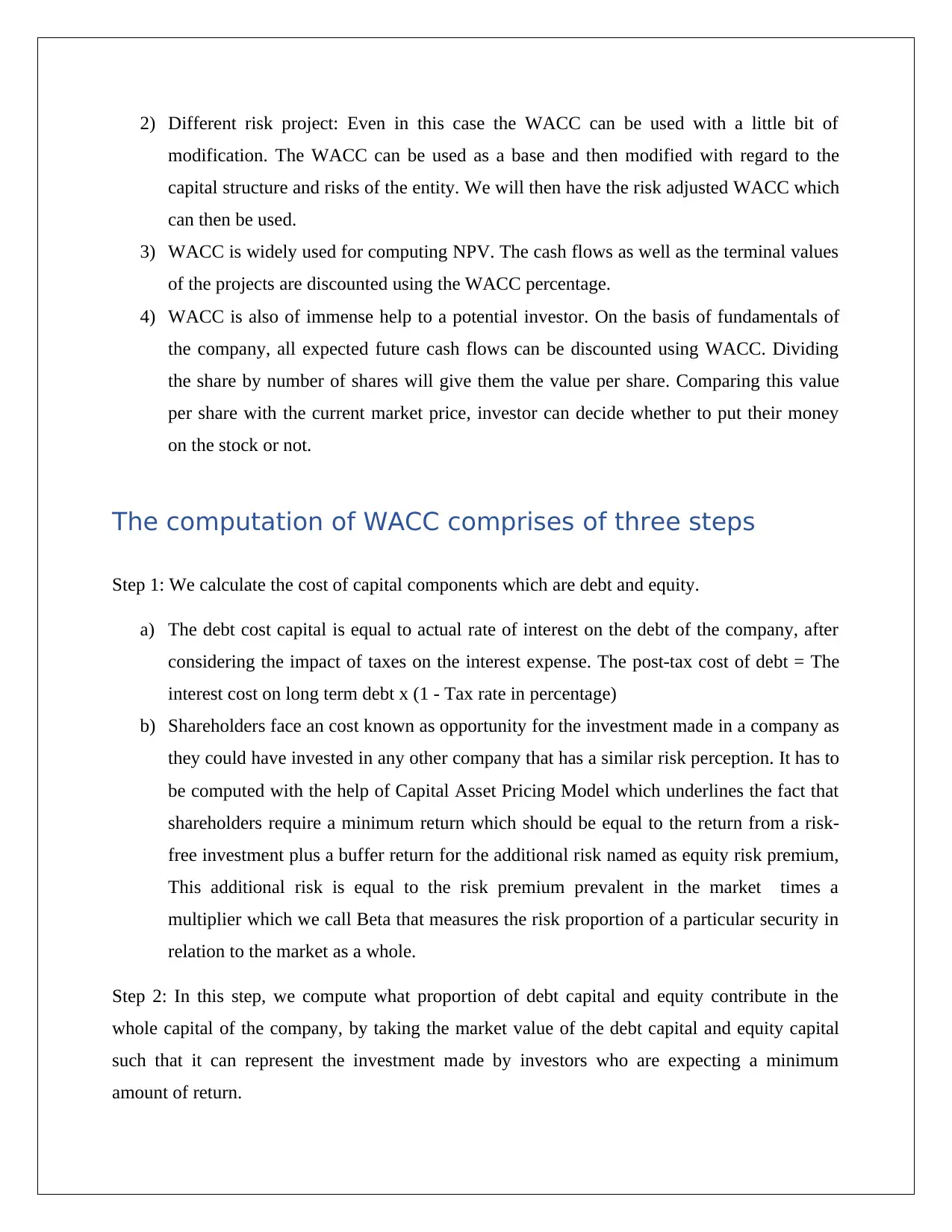
2) Different risk project: Even in this case the WACC can be used with a little bit of
modification. The WACC can be used as a base and then modified with regard to the
capital structure and risks of the entity. We will then have the risk adjusted WACC which
can then be used.
3) WACC is widely used for computing NPV. The cash flows as well as the terminal values
of the projects are discounted using the WACC percentage.
4) WACC is also of immense help to a potential investor. On the basis of fundamentals of
the company, all expected future cash flows can be discounted using WACC. Dividing
the share by number of shares will give them the value per share. Comparing this value
per share with the current market price, investor can decide whether to put their money
on the stock or not.
The computation of WACC comprises of three steps
Step 1: We calculate the cost of capital components which are debt and equity.
a) The debt cost capital is equal to actual rate of interest on the debt of the company, after
considering the impact of taxes on the interest expense. The post-tax cost of debt = The
interest cost on long term debt x (1 - Tax rate in percentage)
b) Shareholders face an cost known as opportunity for the investment made in a company as
they could have invested in any other company that has a similar risk perception. It has to
be computed with the help of Capital Asset Pricing Model which underlines the fact that
shareholders require a minimum return which should be equal to the return from a risk-
free investment plus a buffer return for the additional risk named as equity risk premium,
This additional risk is equal to the risk premium prevalent in the market times a
multiplier which we call Beta that measures the risk proportion of a particular security in
relation to the market as a whole.
Step 2: In this step, we compute what proportion of debt capital and equity contribute in the
whole capital of the company, by taking the market value of the debt capital and equity capital
such that it can represent the investment made by investors who are expecting a minimum
amount of return.
modification. The WACC can be used as a base and then modified with regard to the
capital structure and risks of the entity. We will then have the risk adjusted WACC which
can then be used.
3) WACC is widely used for computing NPV. The cash flows as well as the terminal values
of the projects are discounted using the WACC percentage.
4) WACC is also of immense help to a potential investor. On the basis of fundamentals of
the company, all expected future cash flows can be discounted using WACC. Dividing
the share by number of shares will give them the value per share. Comparing this value
per share with the current market price, investor can decide whether to put their money
on the stock or not.
The computation of WACC comprises of three steps
Step 1: We calculate the cost of capital components which are debt and equity.
a) The debt cost capital is equal to actual rate of interest on the debt of the company, after
considering the impact of taxes on the interest expense. The post-tax cost of debt = The
interest cost on long term debt x (1 - Tax rate in percentage)
b) Shareholders face an cost known as opportunity for the investment made in a company as
they could have invested in any other company that has a similar risk perception. It has to
be computed with the help of Capital Asset Pricing Model which underlines the fact that
shareholders require a minimum return which should be equal to the return from a risk-
free investment plus a buffer return for the additional risk named as equity risk premium,
This additional risk is equal to the risk premium prevalent in the market times a
multiplier which we call Beta that measures the risk proportion of a particular security in
relation to the market as a whole.
Step 2: In this step, we compute what proportion of debt capital and equity contribute in the
whole capital of the company, by taking the market value of the debt capital and equity capital
such that it can represent the investment made by investors who are expecting a minimum
amount of return.
⊘ This is a preview!⊘
Do you want full access?
Subscribe today to unlock all pages.

Trusted by 1+ million students worldwide
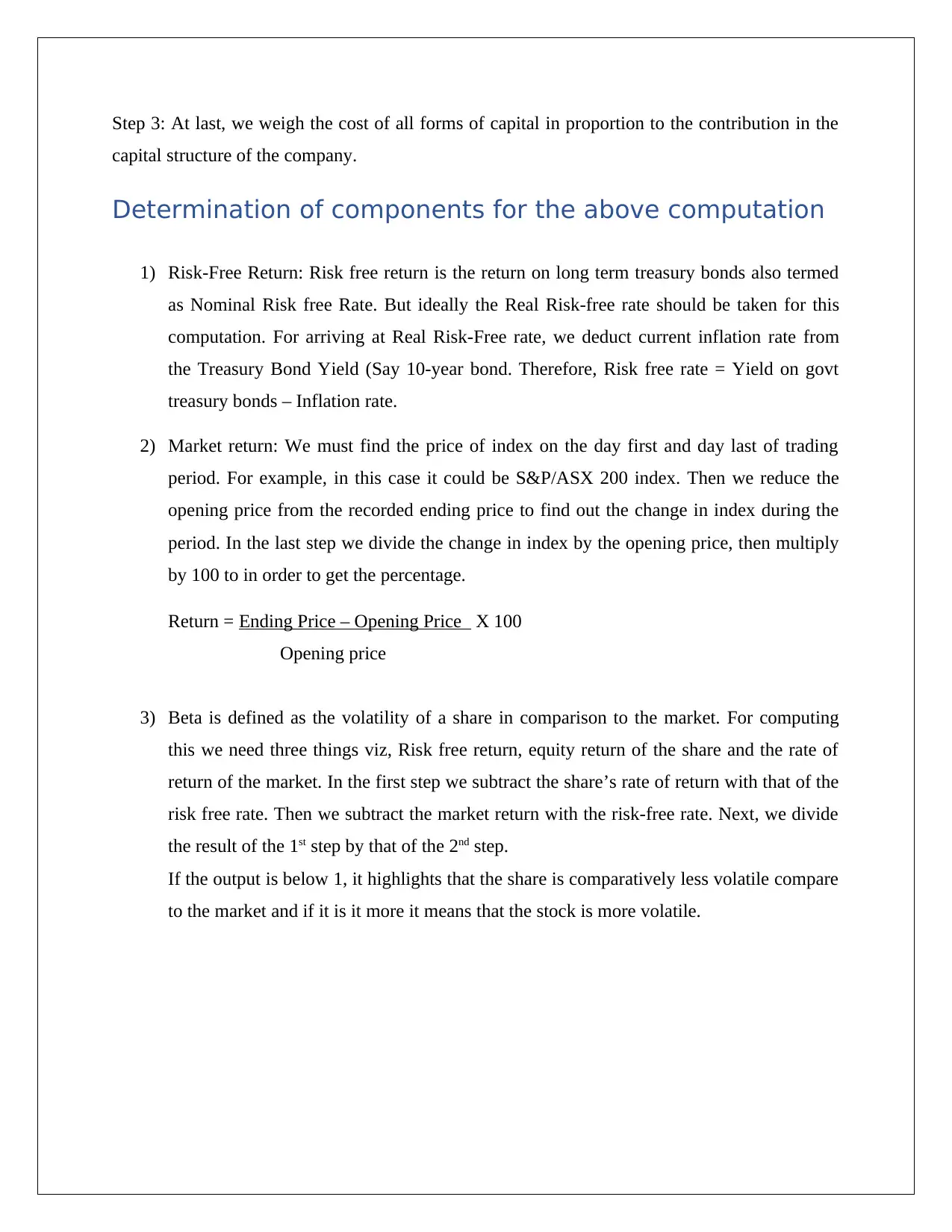
Step 3: At last, we weigh the cost of all forms of capital in proportion to the contribution in the
capital structure of the company.
Determination of components for the above computation
1) Risk-Free Return: Risk free return is the return on long term treasury bonds also termed
as Nominal Risk free Rate. But ideally the Real Risk-free rate should be taken for this
computation. For arriving at Real Risk-Free rate, we deduct current inflation rate from
the Treasury Bond Yield (Say 10-year bond. Therefore, Risk free rate = Yield on govt
treasury bonds – Inflation rate.
2) Market return: We must find the price of index on the day first and day last of trading
period. For example, in this case it could be S&P/ASX 200 index. Then we reduce the
opening price from the recorded ending price to find out the change in index during the
period. In the last step we divide the change in index by the opening price, then multiply
by 100 to in order to get the percentage.
Return = Ending Price – Opening Price X 100
Opening price
3) Beta is defined as the volatility of a share in comparison to the market. For computing
this we need three things viz, Risk free return, equity return of the share and the rate of
return of the market. In the first step we subtract the share’s rate of return with that of the
risk free rate. Then we subtract the market return with the risk-free rate. Next, we divide
the result of the 1st step by that of the 2nd step.
If the output is below 1, it highlights that the share is comparatively less volatile compare
to the market and if it is it more it means that the stock is more volatile.
capital structure of the company.
Determination of components for the above computation
1) Risk-Free Return: Risk free return is the return on long term treasury bonds also termed
as Nominal Risk free Rate. But ideally the Real Risk-free rate should be taken for this
computation. For arriving at Real Risk-Free rate, we deduct current inflation rate from
the Treasury Bond Yield (Say 10-year bond. Therefore, Risk free rate = Yield on govt
treasury bonds – Inflation rate.
2) Market return: We must find the price of index on the day first and day last of trading
period. For example, in this case it could be S&P/ASX 200 index. Then we reduce the
opening price from the recorded ending price to find out the change in index during the
period. In the last step we divide the change in index by the opening price, then multiply
by 100 to in order to get the percentage.
Return = Ending Price – Opening Price X 100
Opening price
3) Beta is defined as the volatility of a share in comparison to the market. For computing
this we need three things viz, Risk free return, equity return of the share and the rate of
return of the market. In the first step we subtract the share’s rate of return with that of the
risk free rate. Then we subtract the market return with the risk-free rate. Next, we divide
the result of the 1st step by that of the 2nd step.
If the output is below 1, it highlights that the share is comparatively less volatile compare
to the market and if it is it more it means that the stock is more volatile.
Paraphrase This Document
Need a fresh take? Get an instant paraphrase of this document with our AI Paraphraser
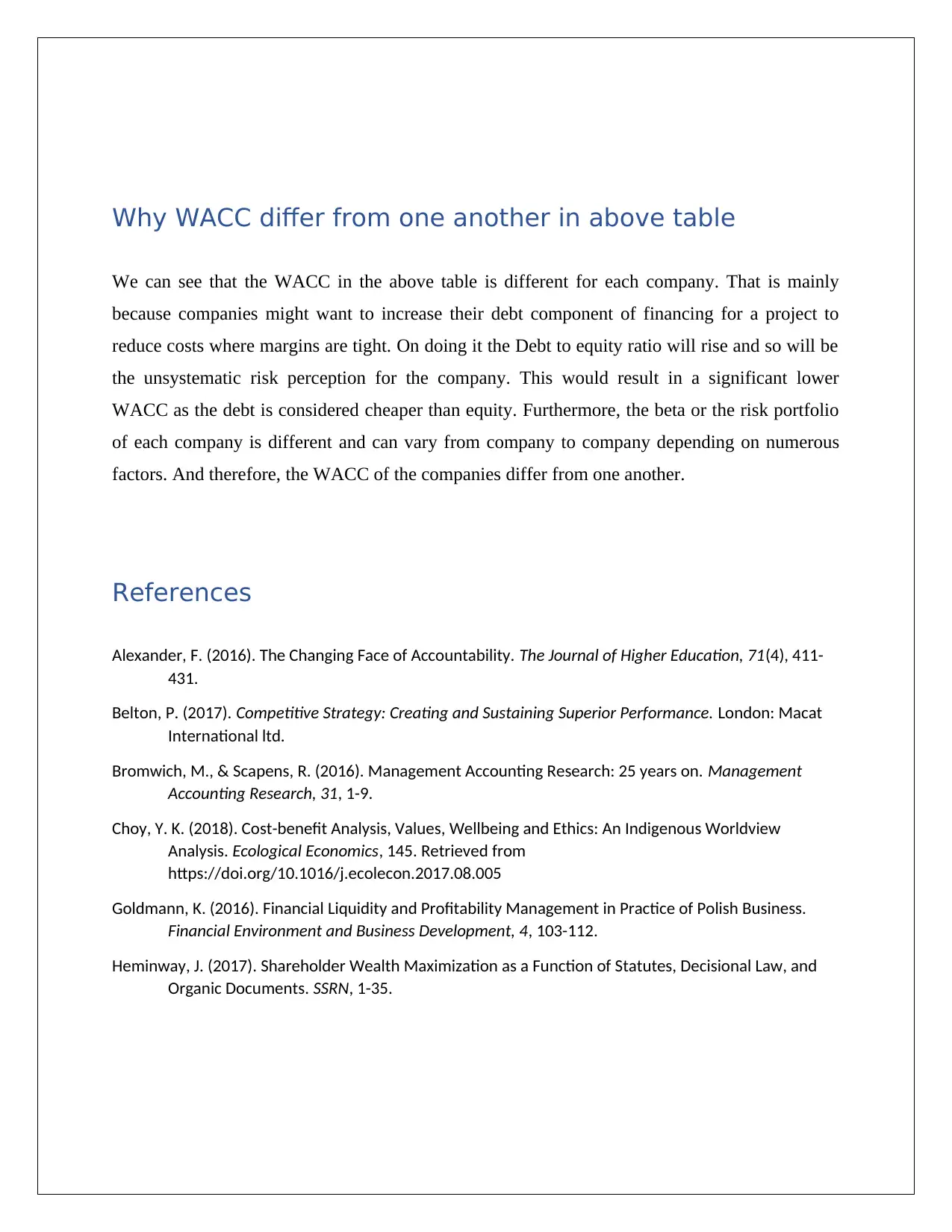
Why WACC differ from one another in above table
We can see that the WACC in the above table is different for each company. That is mainly
because companies might want to increase their debt component of financing for a project to
reduce costs where margins are tight. On doing it the Debt to equity ratio will rise and so will be
the unsystematic risk perception for the company. This would result in a significant lower
WACC as the debt is considered cheaper than equity. Furthermore, the beta or the risk portfolio
of each company is different and can vary from company to company depending on numerous
factors. And therefore, the WACC of the companies differ from one another.
References
Alexander, F. (2016). The Changing Face of Accountability. The Journal of Higher Education, 71(4), 411-
431.
Belton, P. (2017). Competitive Strategy: Creating and Sustaining Superior Performance. London: Macat
International ltd.
Bromwich, M., & Scapens, R. (2016). Management Accounting Research: 25 years on. Management
Accounting Research, 31, 1-9.
Choy, Y. K. (2018). Cost-benefit Analysis, Values, Wellbeing and Ethics: An Indigenous Worldview
Analysis. Ecological Economics, 145. Retrieved from
https://doi.org/10.1016/j.ecolecon.2017.08.005
Goldmann, K. (2016). Financial Liquidity and Profitability Management in Practice of Polish Business.
Financial Environment and Business Development, 4, 103-112.
Heminway, J. (2017). Shareholder Wealth Maximization as a Function of Statutes, Decisional Law, and
Organic Documents. SSRN, 1-35.
We can see that the WACC in the above table is different for each company. That is mainly
because companies might want to increase their debt component of financing for a project to
reduce costs where margins are tight. On doing it the Debt to equity ratio will rise and so will be
the unsystematic risk perception for the company. This would result in a significant lower
WACC as the debt is considered cheaper than equity. Furthermore, the beta or the risk portfolio
of each company is different and can vary from company to company depending on numerous
factors. And therefore, the WACC of the companies differ from one another.
References
Alexander, F. (2016). The Changing Face of Accountability. The Journal of Higher Education, 71(4), 411-
431.
Belton, P. (2017). Competitive Strategy: Creating and Sustaining Superior Performance. London: Macat
International ltd.
Bromwich, M., & Scapens, R. (2016). Management Accounting Research: 25 years on. Management
Accounting Research, 31, 1-9.
Choy, Y. K. (2018). Cost-benefit Analysis, Values, Wellbeing and Ethics: An Indigenous Worldview
Analysis. Ecological Economics, 145. Retrieved from
https://doi.org/10.1016/j.ecolecon.2017.08.005
Goldmann, K. (2016). Financial Liquidity and Profitability Management in Practice of Polish Business.
Financial Environment and Business Development, 4, 103-112.
Heminway, J. (2017). Shareholder Wealth Maximization as a Function of Statutes, Decisional Law, and
Organic Documents. SSRN, 1-35.
1 out of 5
Related Documents
Your All-in-One AI-Powered Toolkit for Academic Success.
+13062052269
info@desklib.com
Available 24*7 on WhatsApp / Email
![[object Object]](/_next/static/media/star-bottom.7253800d.svg)
Unlock your academic potential
Copyright © 2020–2025 A2Z Services. All Rights Reserved. Developed and managed by ZUCOL.




